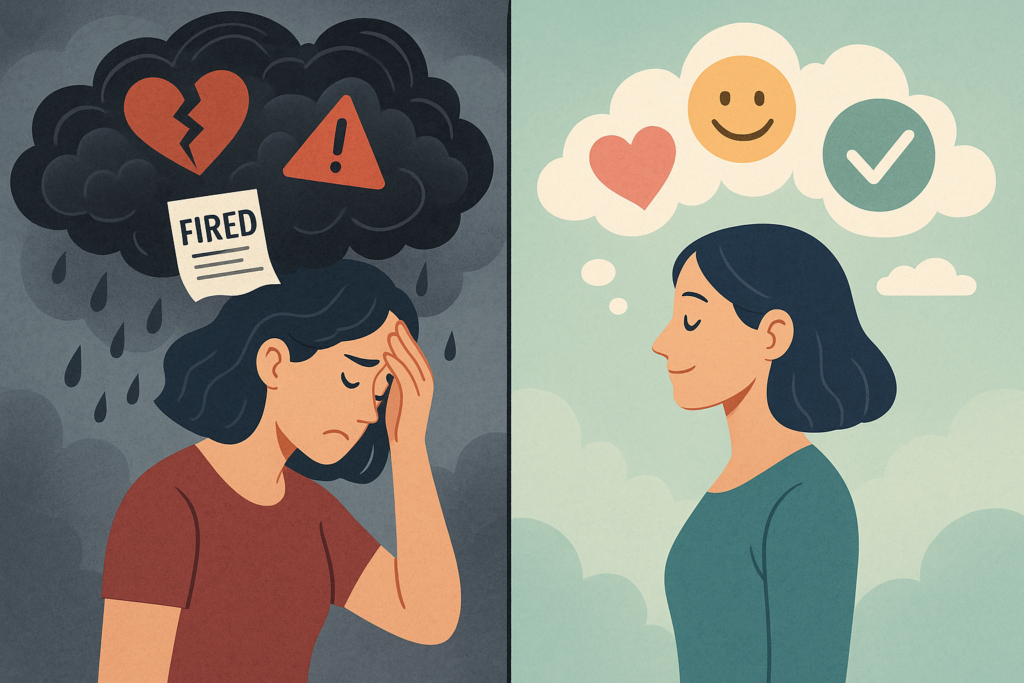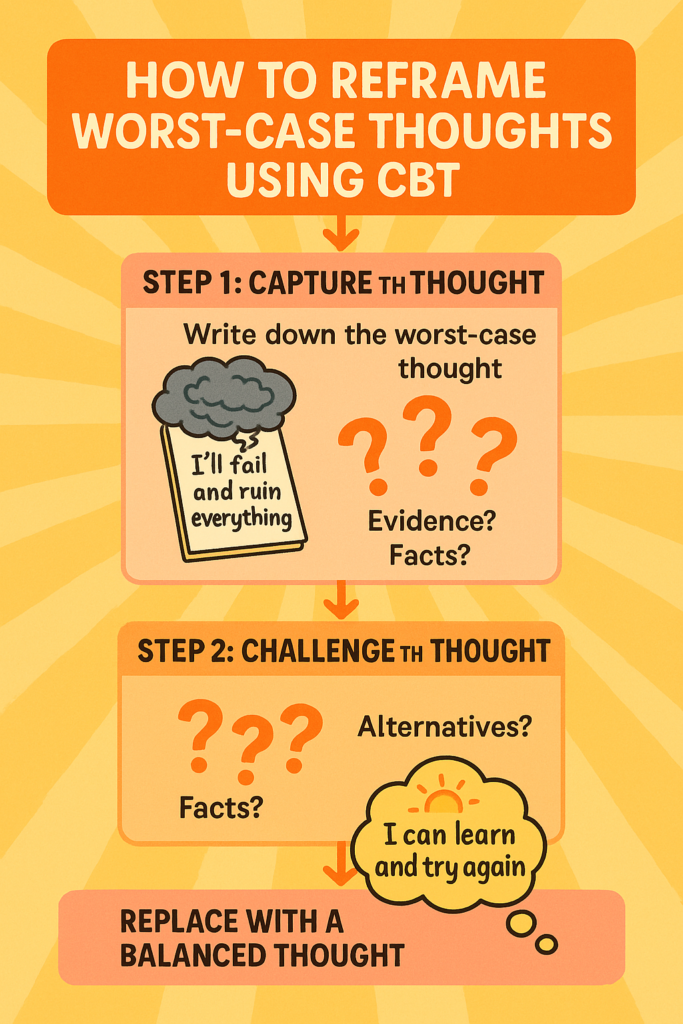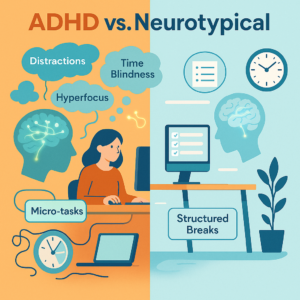Introduction
Catastrophizing, or envisioning the most disastrous outcomes for any scenario, is a mental habit that can fuel intense anxiety and emotional turmoil. From fearing that a small error at work will lead to job loss to assuming a minor symptom indicates a grave illness, this mindset warps reality and heightens stress. Recognizing the damage caused by worst-case thinking and mastering Cognitive Behavioral Therapy (CBT) strategies can help individuals reclaim control over their thoughts and feelings.

The Dangers of Catastrophizing
Catastrophize thinking takes a toll on mental, emotional, and physical health. Here’s why it’s so harmful:
- Heightened Anxiety and Tension: Persistent fears of calamity keep the body in a constant state of alertness, releasing stress hormones like cortisol, which can contribute to chronic anxiety disorders.
- Clouded Judgment: Fixating on catastrophic possibilities hampers clear thinking, leading to indecision, procrastination, or fear-driven choices.
- Damaged Relationships: This thinking pattern can cause excessive worry about others or misreading situations, resulting in conflicts or strained connections with friends and family.
- Diminished Life Satisfaction: The ongoing dread of disaster can stop people from chasing dreams, taking chances, or savoring the moment, fostering feelings of hopelessness.
- Physical Health Strain: The chronic stress of worst-case thinking may lead to issues like sleep problems, fatigue, or a compromised immune system.
Acknowledging these negative impacts is the first step toward dismantling the cycle of worst-case thinking.
CBT Strategies to Overcome Catastrophizing
Cognitive Behavioral Therapy (CBT) is a proven, research-backed method for tackling worst-case thinking. It focuses on spotting and reshaping distorted thought patterns to foster more rational, grounded perspectives. Below are effective CBT strategies to address worst-case thinking:
1. Thought Reframing
- What It Is: Thought reframing involves recognizing irrational thoughts, assessing their accuracy, and replacing them with more realistic alternatives.
- How to Practice:
- Jot down the worst-case thought (e.g., “If I don’t ace this test, my career is over”).
- Question the thought with prompts like:
- What evidence backs this up?
- What evidence disproves it?
- Is this based on facts or guesses?
- Swap the thought for a balanced one (e.g., “Not passing this test would be tough, but I can study harder and retake it”).
- Why It Helps: This method disrupts automatic negative thinking and promotes a more reasoned outlook.
2. Worst-Case Analysis
- What It Is: Worst-case analysis involves confronting the feared outcome and evaluating its likelihood and consequences.
- How to Practice:
- Note the worst-case thought (e.g., “If I stumble during this speech, I’ll be humiliated forever”).
- Reflect on questions like:
- How probable is this?
- If it happened, how would I handle it?
- What’s the most likely outcome?
- Create a plan to manage the situation (e.g., “If I stumble, I’ll pause, smile, and keep going”).
- Why It Helps: Facing the feared scenario and seeing it as unlikely or manageable reduces its emotional grip.
3. Mindful Thought Awareness
- What It Is: Mindful awareness involves noticing thoughts without judgment and letting them pass without fixation.
- How to Practice:
- When a worst-case thought emerges, pause and breathe deeply.
- Acknowledge the thought as merely a thought (e.g., “I’m thinking that everything will fall apart”).
- Shift focus to the present without dwelling on the thought.
- Why It Helps: Mindfulness lowers the emotional weight of worst-case thoughts and fosters detachment from unhelpful patterns.
4. Reality Testing
- What It Is: Reality testing involves acting to verify the accuracy of catastrophic predictions.
- How to Practice:
- Pinpoint a worst-case belief (e.g., “If I ask a question in class, everyone will think I’m clueless”).
- Conduct a small test (e.g., ask a question and note the reactions).
- Evaluate the outcome and adjust the belief based on what happened.
- Why It Helps: Real-life evidence often contradicts worst-case fears, rewiring thought habits.
5. Optimistic Imagery
- What It Is: Optimistic imagery involves picturing a scenario unfolding positively rather than disastrously.
- How to Practice:
- When a worst-case thought arises, pause and imagine a successful or neutral outcome.
- Focus on vivid details, like how you’d feel and what you’d do.
- Practice regularly to build confidence.
- Why It Helps: Visualizing positive outcomes reduces anxiety and nurtures a hopeful mindset.

Practical Steps for Lasting Progress
Beyond CBT strategies, these habits can support ongoing management of worst-case thinking:
- Journaling: Consistently record worst-case thoughts and apply CBT techniques to challenge them, building insight and strength over time.
- Self-Care: Focus on sleep, physical activity, and nutrition to enhance mental and emotional resilience.
- Professional Guidance: A CBT-trained therapist can offer tailored support and accountability.
- Persistence: Rewiring thought patterns takes time, so celebrate small wins and stay committed.
Conclusion
Worst-case thinking can lock individuals in a cycle of fear and worry, but it’s a pattern that can be broken. By understanding its damaging effects and using CBT strategies like thought reframing, worst-case analysis, and mindful awareness, anyone can gain mastery over their thoughts and cultivate a more balanced perspective. With dedication and practice, overcoming worst-case thinking paves the way for greater calm, confidence, and strength in daily life.
References
- Beck, J. S. (2011). Cognitive Behavior Therapy: Basics and Beyond (2nd ed.). Guilford Press.
- Burns, D. D. (1999). Feeling Good: The New Mood Therapy. Harper.
- Clark, D. A., & Beck, A. T. (2010). Cognitive Therapy of Anxiety Disorders: Science and Practice. Guilford Press.
- Kabat-Zinn, J. (2013). Full Catastrophe Living: Using the Wisdom of Your Body and Mind to Face Stress, Pain, and Illness. Bantam Books.
- American Psychological Association. (2020). “Cognitive Behavioral Therapy.” Retrieved from https://www.apa.org/ptsd-guideline/treatments/cognitive-behavioral-therapy

